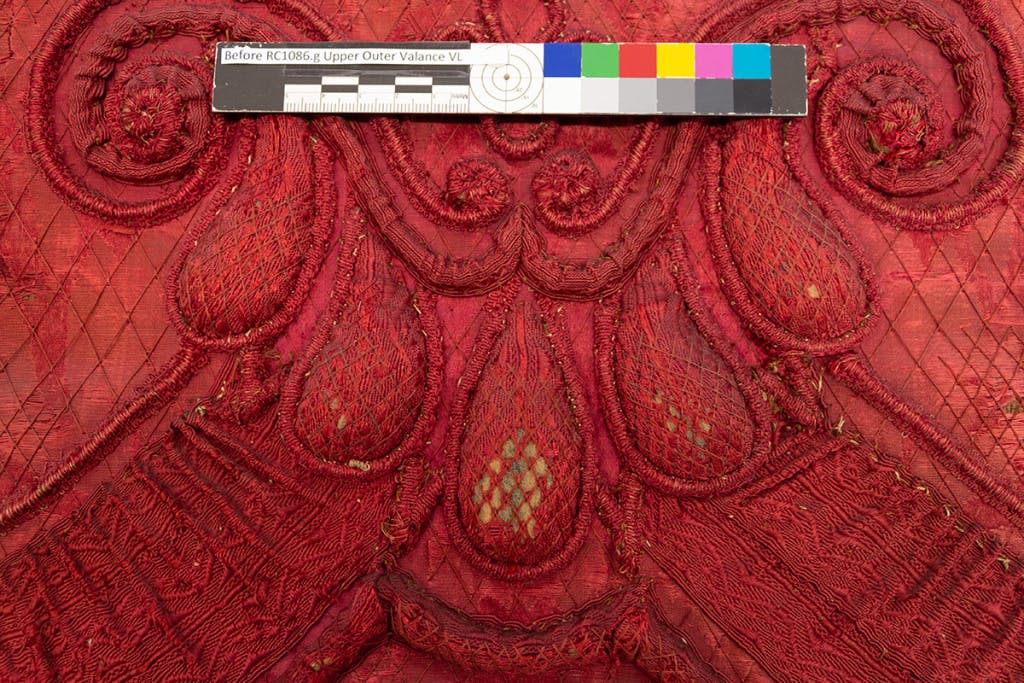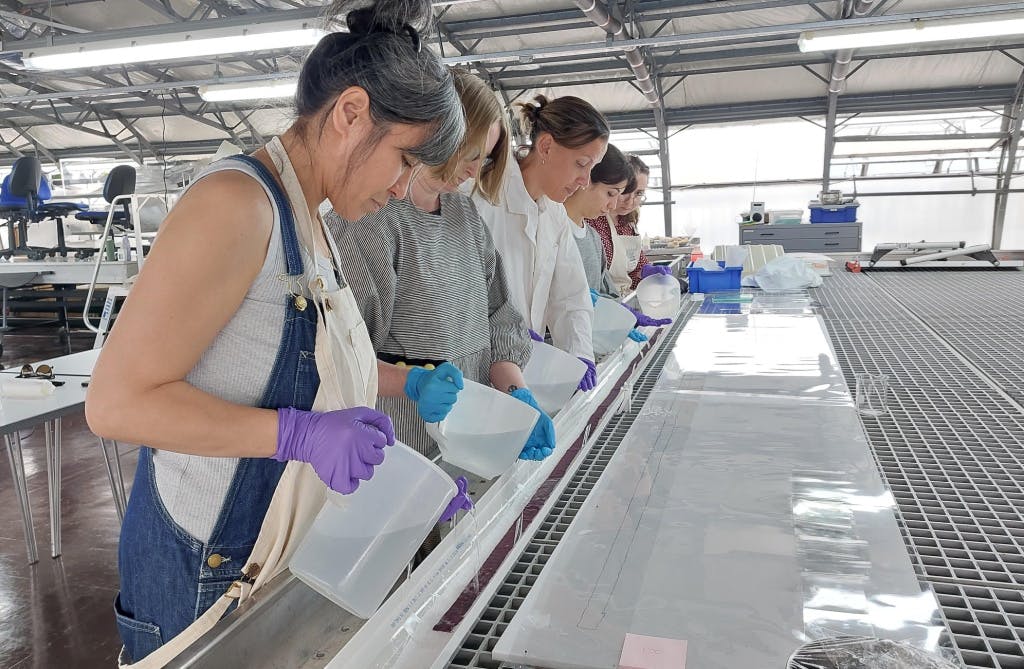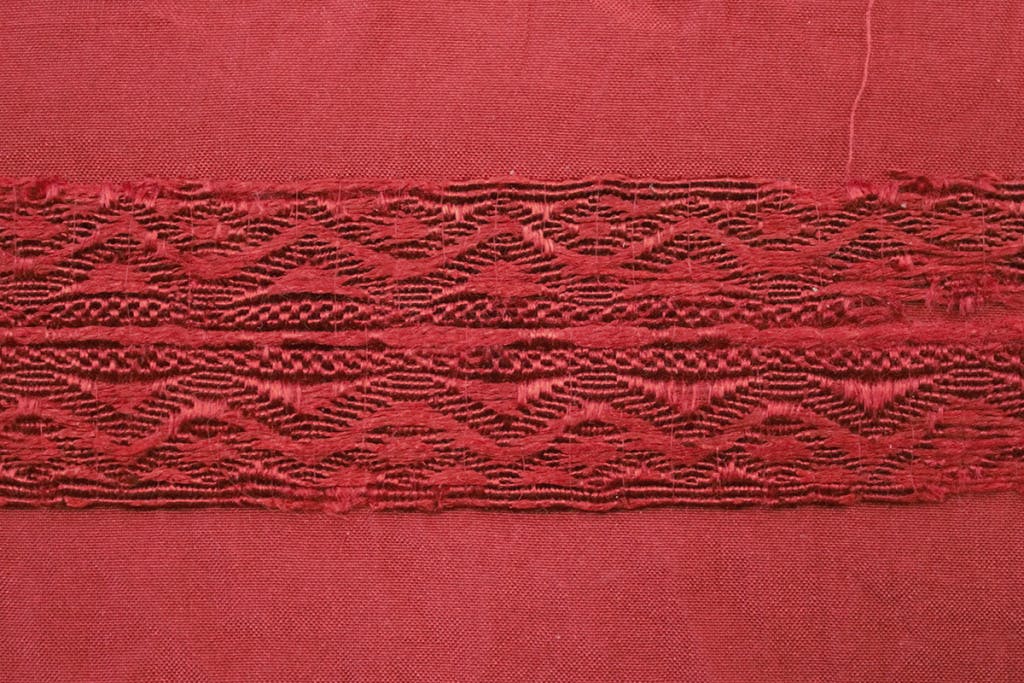Things are looking up! Conserving our upper outer valances
Secrets of a State Bed
Date: 08 November 2024
Author:
Phoebe Ignatia
Work on Queen Caroline’s State Bed, which we care for on behalf of the Royal Collection Trust, continues in the Conservation Studio at Hampton Court Palace. In our last post, we shared our progress on the protective covers for the feet, but this time we have moved up to the top of the bed with the upper outer valances.
Valances are almost always a component of state beds which are complex objects relying on an interconnected series of parts. Queen Caroline's state bed is made up of 62 parts! These three valances feature above the curtains along each side and at the foot of the bed.

Image: Queen Caroline’s State Bed in the apartments at Hampton Court Palace. © Historic Royal Palaces

Image: Three valances feature above the curtains along each side and at the foot of the bed. © Historic Royal Palaces
Removing the valances from the bed frame enables us to get a clearer view of both their condition and construction. It’s a rare opportunity to glimpse the original colour of the silk, visible in areas that have been protected from the light by the pendants hanging over the valances. The contrast is particularly stark on the foot valance because it has been subject to the greatest light exposure from the windows opposite the bed.
The valances are constructed in layers. The intricate silk braid is visible from the front. Applied in a scroll configuration with gathered and raised areas onto silk damask, it features a large compartmented foliate design known as the Hampton Court Palace pattern. Flat silk braid finishes the edges. Underneath this visible layer is a starched linen interlining, silk taffeta and a cotton lining, which was added in the 1980s.

Image: Overall View of Viewing Right Valance. © Royal Collection Enterprises Limited 2024 | Royal Collection Trust
In addition to the original materials, there is also the work of past conservators. In the early 1900s, extensive lines of stitching across the silk damask in a diamond formation, called diaper couching, was carefully completed to prevent loss of the already fragile fibres. Although this is quite different from the method we would use to support the silk today, we are very grateful for the work of our predecessors. Their stitching has held the damask together, preventing what would undoubtedly be a far greater loss of the silk.
From our records, we can see that in 1984 conservators re-enforced particularly fragile areas using the same diaper couching method. Small pieces of damask were inserted under the original couching and couched down again to cover areas where damask had been lost. Fragile areas of braid were covered in crepeline to strengthen it.
To complete conservation treatment, we had to disassemble many areas of the valances. Before we did this, we recorded placement of all the elements to ensure we can re-assemble the parts as they were. Firstly, we removed some of the previous treatment from the 1980s including the lining and patches where the adhesive was starting to fail.
Some of the stitching had to be carefully released for us to separate out the layers; this allowed us to evaluate our treatment proposal before starting with the delicate braid. Once the braid was removed from the valance, we were able to gently wash with conservation-grade detergent. This process removes soiling which improves the appearance and reduces acidity to slow down deterioration. Since cleaning we have been stitching the braid to a silk support fabric.
What's next for Queen Caroline’s state bed? Once we have wet cleaned and supported all four of the braids, we will be carefully re-aligning the folds and curves to re-stitch them in their rightful place on the valances. The braid, raised features and silk damask will be encased with a fine mesh across the front. The fragments of the original silk lining will also be wet cleaned before being placed in between the inter-lining and the whole valance will be supported with a fresh new silk lining. Once this work on the upper outer valances has been completed, we will turn our attention to the cornices, corbels and valance arms with our holistic approach and consideration for the interconnected nature of the elements of the bed.
Phoebe Ignatia
Textile Conservator, Historic Royal Palaces
More from our blog

Using Heritage Science to Conserve Queen Caroline's State Bed
13 September 2024
Work on Queen Caroline’s much-loved State bed, which we care for on behalf of the Royal Collection Trust, continues at Hampton Court Palace and our attentions are now drawn to protecting the feet of this priceless historic object.

Conserving Henry VIII's Abraham Tapestries
18 October 2024
Textile Treatment Conservator Alice Young introduces a new major project at Historic Royal Palaces, to keep the Abraham tapestries looking their best for future generations.

The Wedding of Captain Scott and Kathleen Bruce at Hampton Court Palace
04 January 2024
Assistant Curator Minette Butler explores how Captain Scott's wedding to his beloved wife Kathleen Bruce at Hampton Court Palace intertwines with the aftermath of his ill-fated expedition to reach the South Pole.





